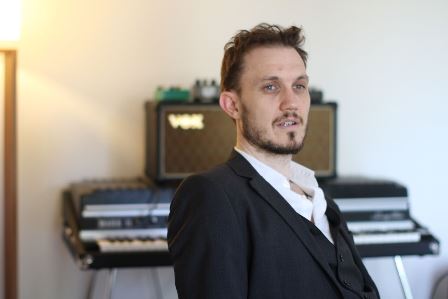Elliott Wheeler.
Aussie Elliott Wheeler is the composer on Baz Luhrmann's Netflix series about the death of disco and rise of hip-hop, 'The Get Down'. Wheeler’s duties included producing and coordinating all the music heard in the show as well as writing his own.
How did you get the Get Down gig?
Baz and I started working together on The Great Gatsby, and then we did the live musical version of Strictly Ballroom. After that finished I moved over to the States to set up there. Baz had mentioned that The Get Down was coming up, and a few months after that I moved over to New York to start working on the show.
What was his brief when he spoke to you?
Just because of the scope of the show and the amount of music that was going to be involved, we wanted to create a musical framework for the storytelling, so that all of the collaborators we were going to be inviting in from hip hop – like Grandmaster Flash and DJ Kool Herc and Kurtis Blow – and from disco – like Nile Rodgers and Sia and Sandy Gold and Michael Kiwanuka – could operate in a sort of cohesive fashion.
Was it a period of music you were already a fan of?
Absolutely. ’77 was such an amazing year because disco was at its pinnacle. It still has the record for the most number of records sold and that was because of disco. It was at its absolute shiniest. Even Frank Sinatra was doing disco. It had been this incredibly vibrant and rich medium and there were so many fantastic disco bands – C.J. & Co, The Spinners, FSB. All these people I absolutely loved. The fascinating thing about the hip-hop that was happening at the time was that there actually wasn’t very much recorded, apart from the bootlegs you can get from that time. So it was really exciting to work with people like Grandmaster Flash and get an oral history and find out what was actually going on in those jams. He would come in and do these sets with the original vinyl that he used in 1977 and these sets sounded exactly like what the people at those parties would have been hearing. And then he brought in Rahiem from the Furious Five, who would take the topline that we needed to get across and rewrite it in the style and flow of ’77.
Was it difficult mixing your own compositions in among all these guest tracks?
It was a wonderful challenge. One of the main tenets Baz had for the show was that the music had to be so interwoven into the plot that if we took out any of the musical numbers the plot itself wouldn’t work. That meant the story would follow where the music was leading it. As a composer that’s an incredible way to work.
Does that mean the music was all mapped out before shooting, rather than in post as per usual?
It was a combination. All of the Get Down Brothers’ numbers had to be performed live, so we would work with the choreographers and the vocal coaches to make sure that those kids were completely rehearsed. Those numbers obviously would be worked out beforehand. The interesting thing with TV is that you’d be writing for one episode while in the middle of shooting another one and then in post-production at the same time (laughs). It got incredibly intense, but it did mean I had a great overview of how the storylines were shaping.
Were you on location a lot or mostly working out of the studio?
Initially we had the big production office out in Queens, and before we even started shooting we had the kids out there on a 1977 boot camp where they were learning to do the hustle and the bustle and learning to break in the style of ’77. Flash would come out there and he would drill them in how to DJ the way he would have been doing it back then. These kids have been listening to rap for the last twenty years which is obviously very different in terms of the style and the flow and how it occurs rhythmically, so they had to unlearn modern rapping and learn how to rap in the style of ’77. So we’d be out on set for the big numbers, making sure everything was going to plan along with our fantastic music supervisors, Stephanie Diaz-Matos and Sarah Bromberg. And then we would come back to our studios in Tribeca and up in Midtown. We recorded with these fantastic musicians – members of the Dap-Kings and their friends – and we’d also do full orchestral recordings. It was great to be able to do all that work in New York, with New York musicians.
Does the Netflix model of dumping all the episodes at once change the approach to storytelling?
The way you finish each episode is slightly different. You know that a lot of people watch more than one episode at a time. It’s a different thing than if you want someone to come back a week later, it’s a slightly different emphasis that you put on the end.
How does part two feel different to the first?
The first half was much more about our young protagonist. It’s much more childlike and innocent in some ways. And I think the second half becomes darker as they enter into adulthood, dealing with the consequences of success. And the responsibilities that come along with that. We were able to push even harder and make some very bold creative decisions.
The Get Down Part II is now on Netflix.


